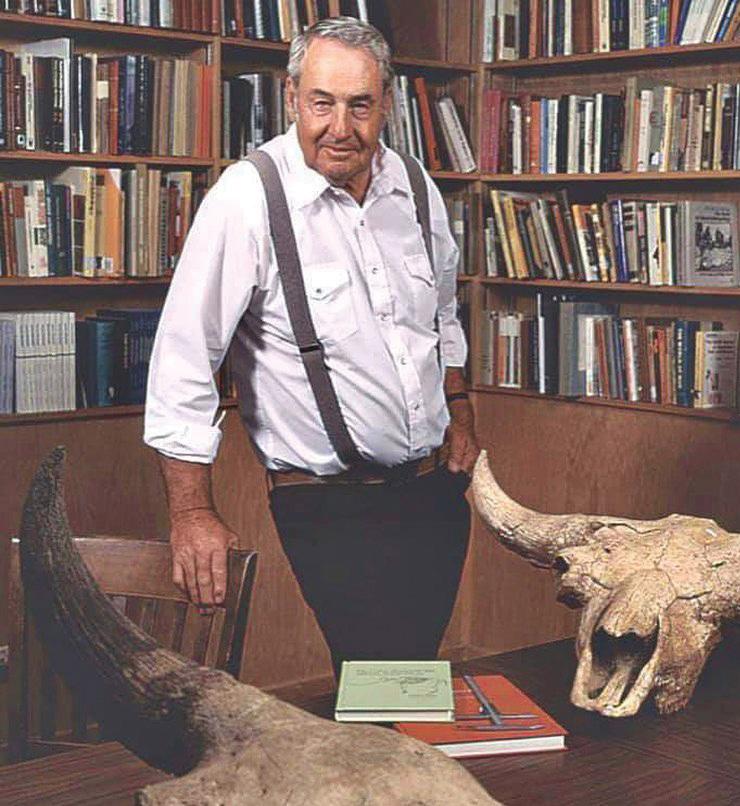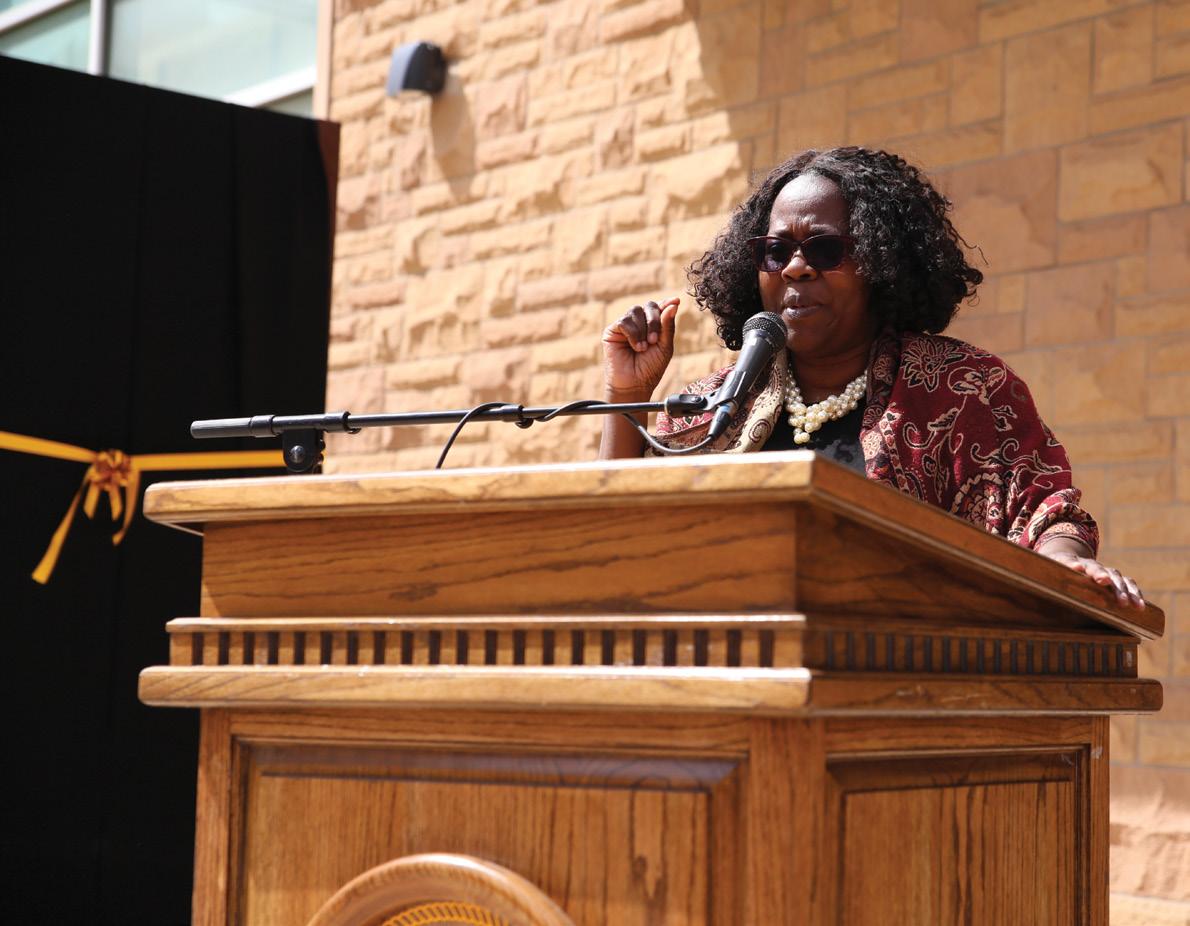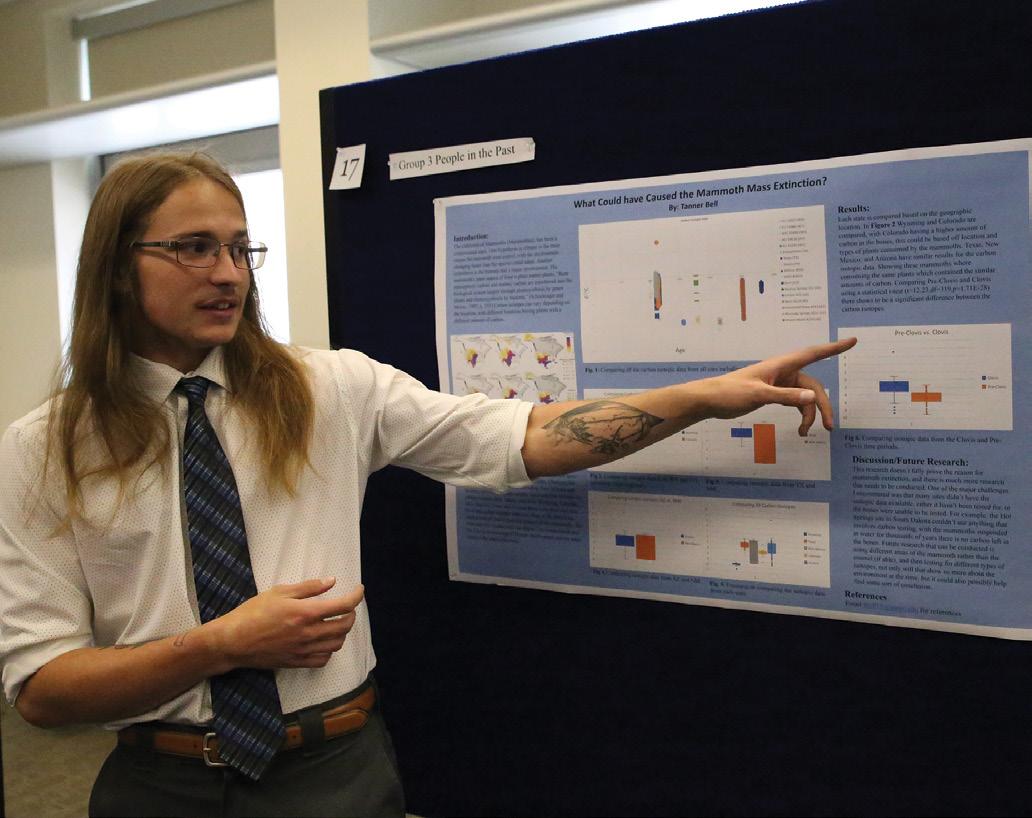
7 minute read
UW Anthropology Building Renamed in the Honor of Legendary George Frison
The Anthropology Building is now named in the honor of storied archaeologist George Frison.
PHOTO BY MARY JUNG
Inset above: George C. Frison left a legacy that continues to be crucial for the College of Arts and Sciences.

PHOTO COURTESY OF THE UW DEPARTMENT OF ANTHROPOLOGY
On Friday, May 6, students, faculty and alumni came together for a ceremony to honor one of the great figures in the long and storied history of the University of Wyoming with the renaming of a building on campus. The Anthropology Building now bears the name of legendary archaeologist and UW professor George Frison.
The newly named George C. Frison Building is a 53,000-square-foot facility that was completed in 2007. The building houses the Department of Anthropology, the State Archaeologist’s Office, the cultural records section of the State Historic Preservation Office, the Frison Institute, the State Archaeological Repository and the Anthropology Museum.
The naming of buildings after people is a rare event at the University of Wyoming. That being said, there is perhaps no one that deserves it more than Frison. Frison left an unmatched legacy in his field as well as an indelible mark on the University of Wyoming.
A LEGENDARY CAREER IN ARCHAEOLOGY
Frison was born Nov. 11, 1924, in Worland and grew up on his grandparents’ ranch near Ten Sleep, spending his early years working sheep and cattle. His interest in archaeology began at a young age,


Left: Former Department Head of Anthropology Todd Surovell and Julie Francis, along with friends, colleagues and former students, gathered to celebrate the legacy of George C. Frison during the renaming ceremony. Right: Former Dean Camellia Moses Okpodu spoke about the inspiration she drew from Frison’s work.
as he spent his spare time collecting arrowheads, exploring caves in the Bighorn Mountains and developing a love for the history and prehistory of Wyoming. This interest originated when Frison first spotted an arrowhead while he was on horseback at the age of 4 or 5.
Frison’s journey at UW started when he enrolled in 1942, but his education was initially cut short when he enlisted in the U.S. Navy, serving in the amphibious forces of the South Pacific during World War II. After being honorably discharged in 1946, he returned to his family ranch.
While operating the ranch, Frison joined the Wyoming Archaeological Society and was an avocational archaeologist, discovering numerous artifacts including atlatl and dart fragments. His interactions with UW Professor William Mulloy prompted Frison to enroll at UW in 1962 at the age of 37 to finish his undergraduate work.
After earning his master’s and doctoral degrees at the University of Michigan, Frison returned to UW in 1967 to head the new Department of Anthropology and serve as the first state archaeologist, a position he held until 1984.
His many awards include the lifetime achievement award from the Society for American Archaeology; a Regents’ Fellowship Award from the Smithsonian Institution; UW’s George Duke Humphrey Distinguished Faculty Award; UW’s Medallion Service Award; and the College of Arts and Sciences Outstanding Alumni Award. He was named to the National Academy of Sciences in 1997.
During his decades of work at UW, Frison made major contributions to the understanding of the prehistory of the northwestern Great Plains in the areas of chipped stone technology, bison bone beds, Paleoindian systematics and Plains chronology. His many books and papers, which include “Prehistoric Hunters of the High Plains,” made him an internationally recognized figure in archaeology.
Frison’s contributions extend far beyond his career as an archaeologist, however, as he also played a very important role in the development of the Department of Anthropology at UW.
“It’s only right that the university honors Dr. Frison’s decades of service to UW and the state by putting his name on the building that houses the programs that would not exist if not for his efforts,” says Professor Todd Surovell, former head of the Department of Anthropology. “Our department would be a shadow of its current self if not for his efforts. Dr. Frison’s contributions to the field of archaeology, the Department of Anthropology, the University of Wyoming and the state of Wyoming cannot be overstated.”
More than 70 students graduated with the Master of Arts degree in anthropology during his tenure at UW, and many more students attended his classes and graduated with undergraduate degrees from the Department of Anthropology.
Among his legacies is the George C. Frison Institute of Archaeology and Anthropology at UW, which funds archaeological research; supports student and faculty participation in international research and education opportunities; sponsors an annual lecture and public talks; and provides for volunteer participation in field and lab programs.
REMEMBERING GEORGE FRISON
Of course, Frison was an integral figure for much more than his storied professional career. His impact on the university as a person was just as apparent as his contributions as a professional during the naming ceremony, with many colleagues, friends and former students coming out for the event.
Former Dean Camellia Moses Okpodu spoke to how the
work of Frison influenced her decision to become a plant physiologist. It was a fond memory of George sitting at a specimen table, identifying fossils that influenced former Dean Okpodu’s early decision to try to name all the flora in her community. Frison’s influence was beyond his discipline. When Surovell approached Okpodu and shared this idea of renaming the building in honor of Frison, she was more than happy to present this idea to the Provost Kevin Carman.
Julie Francis, friend and longtime colleague of Frison, remembered the impact the archaeologist had on the department as a person.
“Doc (Frison) was immensely proud of this building and department. There was no place he would have rather been. He spent nearly every waking moment of his retirement here, continuing to do research, writing and publishing,” Francis said. “If you think about it a little further, this building is kind of the perfect metaphor for George Frison—not for his career, but who he was and how he went about life. Outwardly he was soft spoken, a man of few words. He never abandoned his roots as a rancher from Ten Sleep, Wyoming.”
This is how many remember Frison: a man who never outgrew his roots despite his towering stature in the scientific field. Frison may have been a legend in American archaeology, but he was also just a man who loved natural history, of the world and of Wyoming specifically, as well as sharing this passion with students, colleagues and the curious public.
Those who knew Frison also know that any tribute and discussion about him would be incomplete without mentioning his wife, June. June and George married in 1946 and remained married until her death in 2011. June would often work with Frison as a cook on his field projects and accompanied him on countless expeditions. In 1997, when Frison was elected to the National Academy of Sciences, the Wyoming Legislature declared a “George Frison Day.” During his speech, Frison acknowledged all the people who had helped him to such momentous achievements. He finished by thanking June, claiming that he couldn’t have done any of the things he had accomplished without her.
KEITH KANBE MEMORIAL STUDENT POSTER SYMPOSIUM
While the day served as an opportunity to honor Frison, it was also an event that recognized and remembered Office Associate Keith Kanbe. Kanbe was a beloved employee who passed away Oct. 19, 2021, after suffering from a brief illness. Kanbe was beloved by students and fellow staff alike, making him the perfect person to honor with a celebration by the whole department. See page 24 for more on Kanbe.
In the newly named George C. Frison Building, students had the opportunity to showcase the hard work and research they’ve done over their academic careers with a poster symposium. The event was a great success and served as an appropriate tribute to Kanbe, who will be very missed by all in the Department of Anthropology and the university at large.
The event to honor Frison was a tremendous opportunity to honor him and all the great staff, faculty and students who have come together over the years to make UW Anthropology what it is today. That list of people includes Kanbe as well as countless others. The event may have been chiefly focused on Anthropology’s past, but it also provided a reason for great optimism about the department’s future.
Students spotlight their recent research during the Keith Kanbe Memorial Student Poster Symposium.



